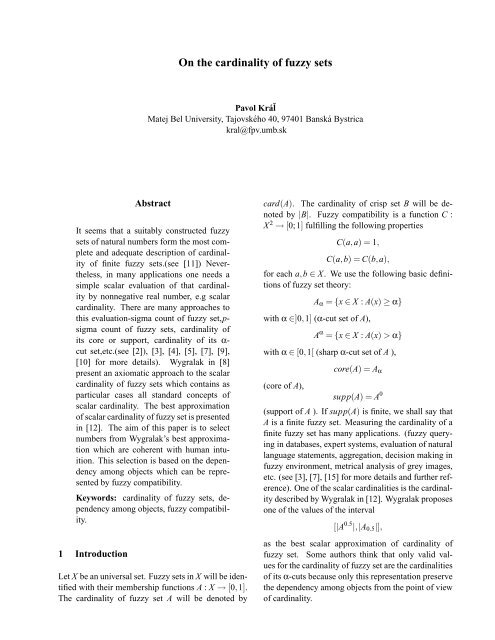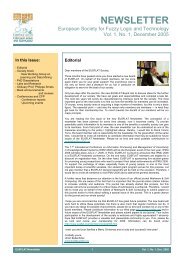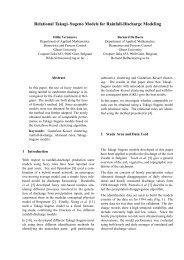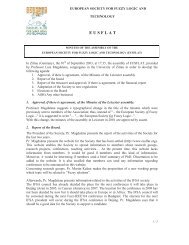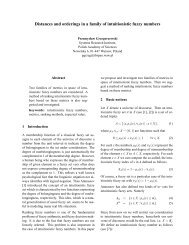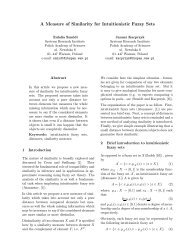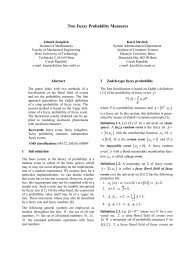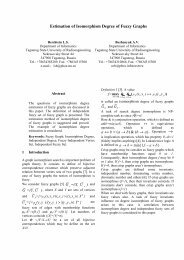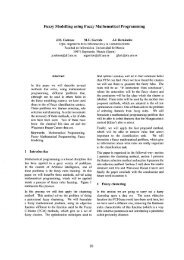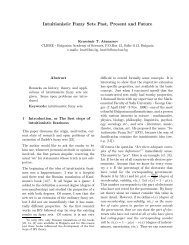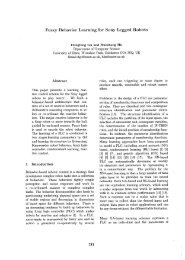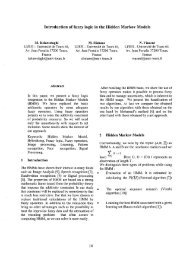On the cardinality of fuzzy sets - EUSFLAT
On the cardinality of fuzzy sets - EUSFLAT
On the cardinality of fuzzy sets - EUSFLAT
You also want an ePaper? Increase the reach of your titles
YUMPU automatically turns print PDFs into web optimized ePapers that Google loves.
<strong>On</strong> <strong>the</strong> <strong>cardinality</strong> <strong>of</strong> <strong>fuzzy</strong> <strong>sets</strong><br />
Pavol Kráˇl<br />
Matej Bel University, Tajovského 40, 97401 Banská Bystrica<br />
kral@fpv.umb.sk<br />
Abstract<br />
It seems that a suitably constructed <strong>fuzzy</strong><br />
<strong>sets</strong> <strong>of</strong> natural numbers form <strong>the</strong> most complete<br />
and adequate description <strong>of</strong> <strong>cardinality</strong><br />
<strong>of</strong> finite <strong>fuzzy</strong> <strong>sets</strong>.(see [11]) Never<strong>the</strong>less,<br />
in many applications one needs a<br />
simple scalar evaluation <strong>of</strong> that <strong>cardinality</strong><br />
by nonnegative real number, e.g scalar<br />
<strong>cardinality</strong>. There are many approaches to<br />
this evaluation-sigma count <strong>of</strong> <strong>fuzzy</strong> set,psigma<br />
count <strong>of</strong> <strong>fuzzy</strong> <strong>sets</strong>, <strong>cardinality</strong> <strong>of</strong><br />
its core or support, <strong>cardinality</strong> <strong>of</strong> its αcut<br />
set,etc.(see [2]), [3], [4], [5], [7], [9],<br />
[10] for more details). Wygralak in [8]<br />
present an axiomatic approach to <strong>the</strong> scalar<br />
<strong>cardinality</strong> <strong>of</strong> <strong>fuzzy</strong> <strong>sets</strong> which contains as<br />
particular cases all standard concepts <strong>of</strong><br />
scalar <strong>cardinality</strong>. The best approximation<br />
<strong>of</strong> scalar <strong>cardinality</strong> <strong>of</strong> <strong>fuzzy</strong> set is presented<br />
in [12]. The aim <strong>of</strong> this paper is to select<br />
numbers from Wygralak’s best approximation<br />
which are coherent with human intuition.<br />
This selection is based on <strong>the</strong> dependency<br />
among objects which can be represented<br />
by <strong>fuzzy</strong> compatibility.<br />
Keywords: <strong>cardinality</strong> <strong>of</strong> <strong>fuzzy</strong> <strong>sets</strong>, dependency<br />
among objects, <strong>fuzzy</strong> compatibility.<br />
1 Introduction<br />
Let X be an universal set. Fuzzy <strong>sets</strong> in X will be identified<br />
with <strong>the</strong>ir membership functions A : X → [0,1].<br />
The <strong>cardinality</strong> <strong>of</strong> <strong>fuzzy</strong> set A will be denoted by<br />
card(A). The <strong>cardinality</strong> <strong>of</strong> crisp set B will be denoted<br />
by |B|. Fuzzy compatibility is a function C :<br />
X 2 → [0;1] fulfilling <strong>the</strong> following properties<br />
C(a,a) = 1,<br />
C(a,b) = C(b,a),<br />
for each a,b ∈ X. We use <strong>the</strong> following basic definitions<br />
<strong>of</strong> <strong>fuzzy</strong> set <strong>the</strong>ory:<br />
Aα = {x ∈ X : A(x) ≥ α}<br />
with α ∈]0,1] (α-cut set <strong>of</strong> A),<br />
A α = {x ∈ X : A(x) > α}<br />
with α ∈ [0,1[ (sharp α-cut set <strong>of</strong> A ),<br />
(core <strong>of</strong> A),<br />
core(A) = Aα<br />
supp(A) = A 0<br />
(support <strong>of</strong> A ). If supp(A) is finite, we shall say that<br />
A is a finite <strong>fuzzy</strong> set. Measuring <strong>the</strong> <strong>cardinality</strong> <strong>of</strong> a<br />
finite <strong>fuzzy</strong> set has many applications. (<strong>fuzzy</strong> querying<br />
in databases, expert systems, evaluation <strong>of</strong> natural<br />
language statements, aggregation, decision making in<br />
<strong>fuzzy</strong> environment, metrical analysis <strong>of</strong> grey images,<br />
etc. (see [3], [7], [15] for more details and fur<strong>the</strong>r reference).<br />
<strong>On</strong>e <strong>of</strong> <strong>the</strong> scalar cardinalities is <strong>the</strong> <strong>cardinality</strong><br />
described by Wygralak in [12]. Wygralak proposes<br />
one <strong>of</strong> <strong>the</strong> values <strong>of</strong> <strong>the</strong> interval<br />
[|A 0.5 |,|A0.5|],<br />
as <strong>the</strong> best scalar approximation <strong>of</strong> <strong>cardinality</strong> <strong>of</strong><br />
<strong>fuzzy</strong> set. Some authors think that only valid values<br />
for <strong>the</strong> <strong>cardinality</strong> <strong>of</strong> <strong>fuzzy</strong> set are <strong>the</strong> cardinalities<br />
<strong>of</strong> its α-cuts because only this representation preserve<br />
<strong>the</strong> dependency among objects from <strong>the</strong> point <strong>of</strong> view<br />
<strong>of</strong> <strong>cardinality</strong>.
Example 1.1 [1] Let X={John, Mike, Peter} be a set<br />
<strong>of</strong> friends, and let us suppose that John is blonde, and<br />
Mike and Peter are fairly blonde. We could say that<br />
John is in <strong>the</strong> set <strong>of</strong> blonde people with degree 1 and<br />
Mike and Peter are in <strong>the</strong> same set with degree 0.5.<br />
Suppose we want to buy a cap for every blonde person<br />
in X. Deciding how many caps we shall buy is<br />
equivalent to obtaining <strong>the</strong> <strong>cardinality</strong> <strong>of</strong> <strong>the</strong> <strong>fuzzy</strong> set<br />
XBLONDE = 1/John + 0.5/Mike + 0.5/Peter.<br />
Following Wygralak’s <strong>cardinality</strong>, <strong>the</strong> possible cardinalities<br />
for XBLONDE are [1,3]. If we are strict with<br />
<strong>the</strong> concept <strong>of</strong> blonde, we shall buy only one cap (for<br />
John). But if we relax our criterion we could think <strong>of</strong><br />
buying three caps. It is clear that buying two caps<br />
is not a solution for <strong>the</strong> problem, i.e <strong>cardinality</strong> <strong>of</strong><br />
XBLONDE can be one or three, but not two. (Mike is<br />
in XBLONDE iff Peter also is )<br />
In our opinion, only for α “near”1 is valid to take into<br />
account <strong>the</strong> dependency among objects with respect<br />
to <strong>the</strong> property “to be in A ”. In o<strong>the</strong>r cases <strong>the</strong> <strong>fuzzy</strong><br />
compatibility is more suitable to express dependency<br />
among objects. Let us consider <strong>the</strong> following example:<br />
Example 1.2 Let A = 0.5/x1 + 0.5/x2 + 0.5/x3 +<br />
0.5/x4 be a <strong>fuzzy</strong> set. The possible <strong>cardinality</strong> for A<br />
belong to [0,4]. If we assume <strong>the</strong> dependency among<br />
objects (from <strong>the</strong> point <strong>of</strong> view <strong>of</strong> <strong>cardinality</strong>) <strong>the</strong> possible<br />
cardinalities are 4 and 0, i.e. each xi is in A<br />
or none <strong>of</strong> xi is in A. Following properties <strong>of</strong> an entropy<br />
measure, proposed in [2], A is <strong>the</strong> fuzziest set<br />
over four objects, i.e we can assume each integer from<br />
[0,4] as a possible <strong>cardinality</strong> <strong>of</strong> A (integer from [0,4]<br />
are equivalent) and we need additional property <strong>of</strong> objects<br />
xi to select <strong>the</strong> best approximation <strong>of</strong> <strong>cardinality</strong>.<br />
The natural additional property <strong>of</strong> objects xi is a <strong>fuzzy</strong><br />
compatibility for example.<br />
We will define <strong>the</strong> selection from Wygralak’s best approximation<br />
which is more appropriate.<br />
Definition 1.1 Let A be a finite <strong>fuzzy</strong> subset <strong>of</strong> X.<br />
Let A(x1),A(x2),...A(xn) are <strong>the</strong> values <strong>of</strong> A. Let<br />
C : A 2 → [0,1] be a <strong>fuzzy</strong> compatibility. Let 0.5 A =<br />
{x ∈ X : A(x) = 0.5}. The possible scalar <strong>cardinality</strong><br />
<strong>of</strong> <strong>fuzzy</strong> set A with respect to <strong>the</strong> <strong>fuzzy</strong> compatibility<br />
is:<br />
<br />
D + A<br />
card(A) =<br />
0.5 i f D > 1<br />
A0.5 else<br />
where D = max<br />
x∈0.5 <br />
|{y ∈0.5 A,: C(x,y) ≥ β : |} and<br />
A<br />
β ∈ [0,1] is a treshold.<br />
Example 1.3 Let A from example 1.2 be a set <strong>of</strong> middle<br />
aged people. Let x1, x2 are 20 year old and x3,<br />
x4 are 60 year old. Let β = 1. Let C1(xi,xj) = 1 iff<br />
xi,xj are in <strong>the</strong> same age and C1(xi,xj) = 0 else. It<br />
is easy to see that card(A) = 2. Let C2(xi,xj) = 1 iff<br />
A(xi) = A(x j) and C2(xi,xj) = 0 else. It is easy to see<br />
that card(A) = 4.<br />
Proposition 1.1 Let A be a finite <strong>fuzzy</strong> set. Let C :<br />
A 2 → [0,1] be a fixed <strong>fuzzy</strong> compatibility.<br />
1. If β → 0 card(A) → |A0.5|<br />
2. If β → 1 card(A) → |A 0.5 |<br />
Proposition 1.2 Let A be a finite <strong>fuzzy</strong> set. Let β be a<br />
fixed treshold<br />
1. If for all i, j,i = j C(xi,xj) < β card(A) = |A 0.5 |<br />
2. If for all i, j,i = j C(xi,xj) ≥ β card(A) = |A0.5|<br />
Proposition 1.3 Let C be a fixed compatibility. Let β<br />
be a fixed treshold. We can construct a naive <strong>cardinality</strong><br />
<strong>the</strong>ory.<br />
The selection <strong>of</strong> a compatibility and a treshold depends<br />
on a concrete case.<br />
References<br />
[1] Delgado, M., Sánchez, D., Martin - Bautista, M.,<br />
Vila, M., A. (2002) A probabilistic definition <strong>of</strong><br />
a nonconvex <strong>fuzzy</strong> <strong>cardinality</strong>. In Fuzzy Sets and<br />
Systems , volume 126, pages 177-190.<br />
[2] De Luca, A., Termini, S.(1972) A definition <strong>of</strong><br />
non-probabilistic entropy in <strong>the</strong> setting <strong>of</strong> <strong>fuzzy</strong><br />
<strong>sets</strong> <strong>the</strong>ory. In Inform. Control, volume 20, pages<br />
301-312.<br />
[3] Dubois, D., Prade, D. (1985) Fuzzy <strong>cardinality</strong><br />
and <strong>the</strong> modeling <strong>of</strong> imprecise quantification.<br />
Fuzzy Sets and Systems, volume 16, pages 199-<br />
230.<br />
,
[4] Gottwald, S. (1980) A note on <strong>fuzzy</strong> cardinals.<br />
In Kybernetika, volume 16, pages 156-158<br />
[5] Kaufmann, A. (1977) Introduction a la <strong>the</strong>orie<br />
des sous-ensembles flous. In Complement et<br />
Nouvelles Applications, volume 4<br />
[6] Liu, Y., Kerre, E., E.(1998) An overview <strong>of</strong><br />
<strong>fuzzy</strong> quantifiers.(I). Interpretations. In Fuzzy<br />
Sets and Systems, volume 95,pages 1-21.<br />
[7] Ralescu, D.(1995) Cardinality, quantifiers, and<br />
<strong>the</strong> aggregation <strong>of</strong> <strong>fuzzy</strong> criteria. In Fuzzy Sets<br />
and Systems, volume 69, pages 355-365.<br />
[8] Wygralak, M. (2000) An axiomatic approach to<br />
scalar cardinalities <strong>of</strong> a <strong>fuzzy</strong> set. In Fuzzy Sets<br />
and Systems, volume 110, pages 175-176.<br />
[9] Wygralak, M. (1997) Cardinalities <strong>of</strong> <strong>fuzzy</strong> <strong>sets</strong><br />
evaluated by single cardinals. In Proc. IFSA<br />
Congress Praha, pages 73 - 77<br />
[10] Wygralak, M. (2001) Fuzzy <strong>sets</strong> with triangular<br />
norms and <strong>the</strong>ir <strong>cardinality</strong> <strong>the</strong>ory. In Fuzzy Sets<br />
and Systems, volume 124, pages 1-24.<br />
[11] Wygralak, M. (1993) Generalized cardinal numbers<br />
and operation on <strong>the</strong>m. In Fuzzy Sets and<br />
Systems, volume 53, pages 49-85.<br />
[12] Wygralak, M. (1997) <strong>On</strong> <strong>the</strong> best scalar approximation<br />
<strong>of</strong> <strong>cardinality</strong> <strong>of</strong> a <strong>fuzzy</strong> set. In<br />
International journal <strong>of</strong> uncertainty, fuzziness<br />
and knowledge-based systems, volume 56, pages<br />
681-687.<br />
[13] Wygralak, M. (1999) Question <strong>of</strong> <strong>cardinality</strong> <strong>of</strong><br />
finite <strong>fuzzy</strong> <strong>sets</strong>. In Fuzzy Sets and Systems, volume<br />
102, pages 185-210.<br />
[14] Wygralak, M. (1999) Scalar cardinalities <strong>of</strong><br />
<strong>fuzzy</strong> <strong>sets</strong> with triangular norms and conorms.<br />
In Proc. Inter. Eur<strong>of</strong>use - SIC 99 Conf. Budapest,<br />
pages 322-327.<br />
[15] Zadeh,L. A. M (1983) A computational approach<br />
to <strong>fuzzy</strong> quantifiers in natural languages.<br />
In Comput. Math. Appl., volume 9, pages 149-<br />
184.


